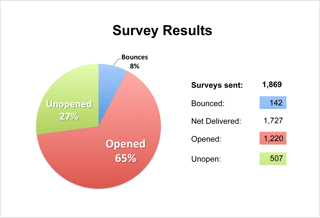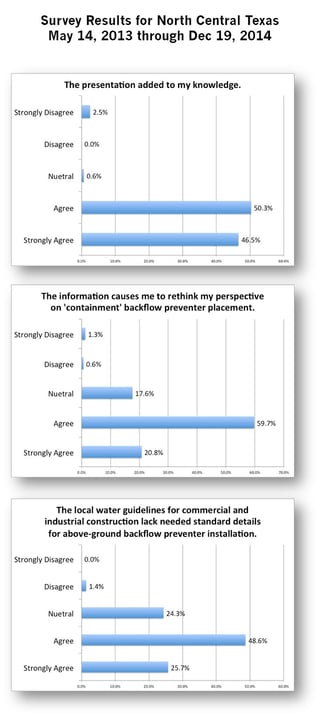 From May 2014 to April 2016 I have presented a continued education module on Design Best Practices for Containment Backflow Preventer Installation and Placement. In that 2-year period I presented to 1,869 professional plumbing and civil engineers. Of those, 1,222 responded by providing their specific area of specialty and then went on to answer three questions and, in many cases, added additional feedback. The dispersion of field specialty was 817 (66.8%) civil engineers, 366 (29.9%) plumbing engineers, and 39 (0.03%) who categorized themselves as “other”. In most cases, these were EITs and construction project managers. Below you'll find the questions and their collective answers, which reveal the direction these design engineers would like to see the industry go.
From May 2014 to April 2016 I have presented a continued education module on Design Best Practices for Containment Backflow Preventer Installation and Placement. In that 2-year period I presented to 1,869 professional plumbing and civil engineers. Of those, 1,222 responded by providing their specific area of specialty and then went on to answer three questions and, in many cases, added additional feedback. The dispersion of field specialty was 817 (66.8%) civil engineers, 366 (29.9%) plumbing engineers, and 39 (0.03%) who categorized themselves as “other”. In most cases, these were EITs and construction project managers. Below you'll find the questions and their collective answers, which reveal the direction these design engineers would like to see the industry go.
The Questions
Each question illuminates something important about the state of awareness among civil and mechanical designers regarding  containment backflow prevention.
containment backflow prevention.
- The presentation added to my knowledge.
96.8% said they agreed or strongly agreed. This is clear evidence that the material is not widely understood. It at least suggests that presently, there is no platform for education in this area at all.
- The Information causes me to rethink my perspective on containment backflow preventer placement.
80.5% said they agreed or strongly agreed. This would be meaningful if it were 40%. The fact that we are seeing such ascent to the need for knowledge about best practices is somewhat disquieting. Moreover, only 17.6% concluded by virtue of a neutral response, that what they now know is well aligned with best practices. Finally, 1.9% disagreed or strongly disagreed. We see this rebel response throughout the questions and indicate some bias perhaps against the product, the presenter, or a previous experience. Keep in mind; this equates to roughly 23 people out of 1,222.
- The local water guidelines for commercial and industrial construction lack needed standard details for above-ground backflow preventer installation.
74.3 percent of the design engineers surveyed either agreed or strongly agreed with this question. In our opinion, this is the most important information obtained from the survey. There are myriad approaches to this design. Read more about those here. and the complaints among engineers have reached a fevered pitch. The local water authority needs to provide standard details that clearly lay out their aspirations for backflow preventer installation and design. It is our strong recommendation that they follow recognized best practices. But even if they refuse to align with the latest and best thinking surrounding the water safety and property damage risks, they should nevertheless provide clear guidance to the design community.
Why Civil Engineers?
According to the American Water Works Association (AWWA) and the American Society of Plumbing Engineers (ASPE), best practices are only followed when the assembly is placed in an area that will not flood. That means that except for the very smallest of devices, i.e., 2 inches and less, containment backflow preventers must be placed outside the building. Because sudden floodwater flows discharged from RPZs require surface grading and contouring, a civil engineer is the only designer armed with the capabilities to accomplish that task. Even when the application does not demand an RPZ, the latest guidance from The Foundation of Cross Connection Control and Hydraulic Research at the University of Southern California advises that even the double check valve backflow assembly should be installed aboveground because of the dangers associated with flooded vaults.
Change has Started
Because of some new warnings from industry leaders and important organizations such as the ASPE and the AWWA, there is now a new interested-party in these affairs: the casualty carrier. Design errors lawsuits have emerged where the property losses due to indoor flooding have subrogated to the plumbing engineer. This has obviously hastened interest to move this to the civil engineer. Perhaps that explains a learning session scheduled at this year’s ASPE national convention in October, “Let the Civil Engineer Deal with the Containment Backflow System."




